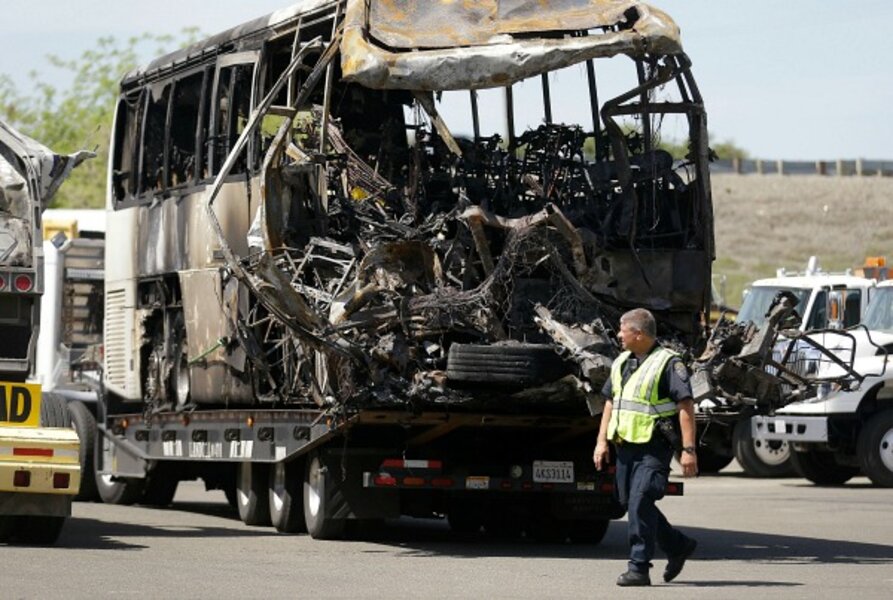California fatal bus crash: Was FedEx truck cargo involved?
Loading...
Last week’s fatal crash involving a bus full of California high school students wasn’t the first instance of a FedEx truck bursting into flames.
In Corte Madera, Calif., Friday – the day after the head-on crash along the I-5 interstate highway that killed 10 people – the driver of a smaller FedEx truck saw smoke coming out of the cargo area. By the time he had driven it to the back of a parking lot, the cargo area was ablaze.
Fire investigators suspect either an electrical malfunction or a chemical reaction caused the fire. The truck was carrying chemicals, although none of them appears to have leaked.
There have been other recent FedEx truck fires as well.
In mid-February, a FedEx truck making a pick up in Sweetwater, Texas, caught fire. Later that month, a FedEx tractor trailer caught fire and was totally destroyed along I-81 near Roanoke, Virginia. In March, a FedEx truck fire shut down a portion of I-80 near Park City, Utah.
It may just be coincidental, but witnesses say the large FedEx two-tractor trailer that barreled across a median and into the bus was emitting flames before the crash that killed five students and their three chaperones on the way to a college visit, plus the drivers of both vehicles.
Bonnie and Joe Duran were in their Nissan Altima in front of the bus when the truck came across the grassy median, side-swiping their car before hitting the bus.
"I just looked to the left, and there it was coming through right at me at an angle. I can tell I wasn't going to outrun him, so I just kind of turned to the right and he hit me," Bonnie Duran told a local TV affiliate. "It was in flames as it came through the median…. It wasn't like the whole thing was engulfed. It was coming up wrapping around him."
Although the investigation is just beginning, such a fire might suggest that the truck driver had been overcome by smoke or chemical fumes. There were no truck skid marks, apparently indicating that he had not applied the brakes. Details of the tractor-trailer’s cargo – whether or not it might have included chemicals or batteries, for example – have yet to be reported.
Federal investigators say they haven't found any physical evidence that the FedEx truck was on fire before the collision. National Transportation Safety Board member Mark Rosekind said Sunday that investigators are not ruling out a pre-impact fire, but they did not find any physical evidence at the crash scene.
The bus was gutted and the truck was a mangled mess, making it difficult for investigators to determine whether a fire started in the truck before impact. Mr. Rosekind said investigators planned to look at blood tests to determine whether the FedEx driver inhaled smoke before the collision, and whether he was impaired.
A blood test will also be conducted for the bus driver, who had only been driving a short time after relieving another driver during a stop in Sacramento. Rosekind said more than 145 feet of tire marks showed that the bus driver tried to brake and swerve to the right to avoid being hit.
Fire safety has been a longstanding concern of the NTSB.
After a 2005 bus fire killed 23 nursing home evacuees escaping Hurricane Rita in Texas, the agency called for safety standards that could make buses less vulnerable to fire, including improved protection of fuel tanks. More recently, the NTSB says buses must have sophisticated suppression systems to control fires, much as high-rise buildings have sprinkler systems.
As part of its investigation into Thursday's crash, the NTSB will also evaluate whether there should have been a barrier on the median to help prevent head-on collisions. Barriers are required when medians are less than 50 feet wide; this one was 60.
This report includes material from the Associated Press.






